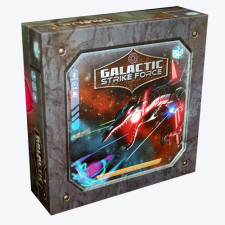Galactic Strike Force Review
on Nov 19, 2015
Some games seem more awesome in theory than they are in practice. Galactic Strike Force is one of them. Players take the role of unique pilots each with a unique deck. They are the galaxy’s last hope as one of four different evil invaders attempts to conquer or destroy their corner of the universe. Through various phases, players can power up, improve their ship and draw deck, and then bring new weapons to bear on the evil ships. Players can win by ridding the galaxy of all enemies, but more often it requires going toe to toe with the flagship of the invader. With so much awesome packed into the box, what’s not to like? Well…
GSF is at least thematically appealing, it allows players strategic opportunities, the cooperative nature fosters a lot of discussion, and the variety of cards ensures that no two games will play out the same. These are the good things. Pity about the rest.
Play begins with three sectors in play. Each sector will be attacked by the villain’s ships each turn. And each sector has a special rule or power applicable only in that sector. Thus, different tactics may be needed, or some players might have a ship more capable of dealing with certain sectors. But despite all of the neat ideas and being created by the designer of Sentinels of the Multiverse, one of my favorite games of all time, the box also includes a ton of nonsense and bookkeeping that really detracts from what should be a fun and exciting challenge.
The game goes through several phases. There are no true turns in the game, so players are free to take individual actions in whatever order most benefits them within a given phase. This leads to a lot of discussion about who should go first when buying new tech and who will most benefit. While this unique non-turn structure allows for strategic choices, it is one of the few positive elements.
Combat, which should provide the most tension and excitement, is a let down. In GSF, you compare the firepower of one ship to the defense of another. If the firepower is higher, then it deals damage to the other ship, and damage is represented by losing defense or weapon points. But if a ship has higher defense, it takes no damage.
So you end up in a situation where you can get to a critical mass of defense and a player’s ship effectively becomes unstoppable. And it also stops any strategy of sacrificial plays or whittling a difficult enemy into something more manageable. Here, you basically have to become more powerful than the villain to even do damage at all. And that becomes a bit of a bore. If you are already more powerful than the bad guy … why should we be scared of him? It means you really won a few turns earlier and now you’re just letting the game play out. Not exciting.
But this one flaw, while not ideal, could be overlooked or potentially even house ruled. The bookkeeping, though, is just unreal. When villain cards come out, they often don’t do things right away. Instead, they have one or more symbols. Each symbol corresponds to one of the five phases of the game. When that phase begins, the ability triggers and whatever bad thing occurs. But that means, at the beginning of each phase, you have to go from villain card to villain card and double check to see what, if anything, happens. Many of them also trigger in multiple phases. So you can’t just pile them up by phase and end up re-examining them six times every turn.
Which wouldn’t be so bad if there were just a few bad guys. But there can be tons of villain cards – definitely into the double digits. Indeed, the game starts with one villain per player, plus three more villains. And new ones come out every turn. In order to fit multiple phases worth of abilities on those cards, the print is fairly small. The result is that you find yourself constantly checking cards, over and over again, multiple times each turn to remind yourself which does what when. And not just as the phases change, but as the players prepare for each phase and who they should attack, they have to review them then as well.
Rather than evoke a tense do-or-die atmosphere as alien invaders strike against your homeland, GSF mainly evokes tedium. You look at the same cards so often that they quickly lose their flavor and the experience quickly becomes themeless. And the unfortunate combat choices have the players building up and playing out well beyond when the game becomes fun. Instead of providing a tense cooperative arch, it feels like you’re simply joylessly grinding out levels.
Plus, the mechanics are sometimes at odds with the theme. Often (not always), it can be good to simply abandon two sectors to the villain ships and instead focus on defending one. The villain doesn’t win unless he conquers all three sectors. So give two up and it doesn’t matter. And with all the good guys in one sector, it can be easier to manage the influx of ships.
You wrap all of that together, and GSF simply doesn’t make the grade. Is it a total stinker that all rational beings should avoid? Not at all. It has fun moments and the turn structure (or lack thereof) is something I’d like to see in more cooperative titles. It also makes it easy to customize the difficulty and allows for numerous hard modes. But this title is significantly flawed. If you know that going in, and don’t mind the constant review of villain cards, then this game might be a winner. For me, though, I found the disappointment too great.

 Customer Support
Customer Support  Subscribe
Subscribe 




 Account
Account  Wishlist
Wishlist 

